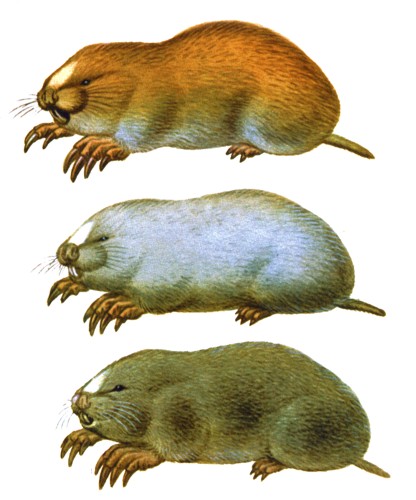Pests
Myospalax myospalax Laxmann - Siberian Zokor, Mole-rat
Synonyms.
Myospalax laxmanni Beckmann, Mus myospalax Laxmann, Myospalax laxmanni Brandt.Systematic position.
Class Mammalia, order Rodentia, family Muridae, genus Myospalax.Biological group.
Rodent pests.Morphology and biology.
Body length is 260 mm, tail 65 mm. Upper side of body is mainly reddish-brown; the color is lighter on sides and ventrum. The tail has whitish tint. Auricles are small and concealed by fur. Fore legs are short; claws are long and crescent-shaped. Adult males weigh, on average, 503 (225-720) g; females weigh 402 (200-540) g. One molt per year is characteristic for the Zokor, occuring in April-November. It has 1-10 young per litter, more often 3-5, 4.5 on the average. The birth occurs in the last third of March. Youngs are born blind and glabrous; they grow quickly and start settling from a parent burrow in the second half of June during the greatest intensity of plant vegetation. Sexual maturity of males and females appears at the age of 7-8 months. Sex ratio is 1:1.5 with prevalence of females in populations.Distribution.
This is an inhabitant of open landscapes and mountains in Eastern Kazakhstan, in the South of Western Siberia, in central, southern and western Altai. Area reduction in the historical time southward and southeastward lasts nowadays.Ecology.
The Siberian Zokor inhabits steppes and forest-steppes with soft meadow soils and rich grass vegetation; avoiding dry steppes and also solonetzic, stony and rubbly plots; reaching remote areas of woodlands through meadows. In mountains, this species occurs up to subalpine meadows at heights of 2300-2800 m above sea level. Mole-rats conduct an underground way of life; their burrows consist of nest chambers where they live continuously and reproduce, fodder chambers, special places for excrements, and fodder tunnels of 8-12 cm in diameter being laid at the depth of 5-27 cm. In spring, the total length of all tunnels is, on average, 52 (20-150) m, increasing later. The burrow entrance is usually closed. The nest chamber can be located at a depth of 3-4 m. The animal digging activity begins in April and lasts until soil freezing at a depth of 10-20 cm. Digging burrows, the animals form soil hills weighing sometimes 4.5 kg and being 25 (20-34) cm in diameter. The Siberian Zokor can build continuous, belt, island, and sporadically focal settlings. A list of fodder plants counts 89 species of wild plants and 10 cultures; their bulbs, rhizomes, and tubers are stored for winter period. In the Southern Altai and in Tarbagatay, the Siberian Zokor begins to store fodder from middle third of June and continues until freezing of upper soil layer. Weight of supplies can reach 8 kg in autumn, and 4 kg in spring. Settling near potato fields, these rodents store tubers in fodder chambers. Animal feed (small rodents, earthworms) is a small part of its ration. The Steppe Polecat (Mustella eversmanii) and foxes are the most dangerous enemies. As many as 12 species of Gamasid mites and fleas parasitize on the Siberian Zokor. The basic limiting anthropogenic factor is the destruction of biotopes by plowing and other agricultural activity.Economic significance.
Through reduction of its area, the species loses negative economic significance. The Siberian Zokor increases meadow vegetation mosaic, throwing out soil on the ground surface, but reduces efficiency of haymaking. In the first half of 20th century, this species was an object of fur trade, with a maximum production in 1939, when 62,000 zokor skins had been prepared. Now it is seldom traded. It causes the greatest harm to alfalfa crops and kitchen gardens, especially to sprouts and early cultures in spring. Measures of control in places of local concentration are trapping, use of poisoned baits, gas method, and flooding of burrows with water.Reference citations:
Gromov I.M., Erbaeva M.A. 1995. The Mammals of Russia and adjacent territories. Lagomorphs and Rodents. St. Petersburg: ZIN RAN, 552 p. (in Russian).Hutchins M., Kleiman D.G., Geist V., and McDade M.C., eds. 2003. Grzimek.s Animal Life Encyclopedia, 2nd edition. Vol. 16, Mammals V. Detroit et al.: Farmington Hills, MI: Gale Group, 586 p.
Makhmutov S.M. 1969. Economic significance of the Siberian zokor (Myospalax myospalax Laxm.) in Eastern Kazakhstan. In: Izvestiya AN Kazakhskoi SSR. Seriya biologicheskaya (4). Alma-Ata: Nauka, p. 39.47 (in Russian).
Makhmutov S.M. 1971. Nutrition and pest damage of the Siberian zokor in Eastern Kazakhstan. Vestnik selskokhozyaistvennoi nauki (5): 107-111 (in Russian).
Myospalax myospalax. Wilson & Reeder.s Mammal Species of the World. Third Edition. Bucknell Univesity. 2005. http://www.bucknell.edu/msw3/browse.asp?id=13000206 .
Ognev S.I. 1947. Animals of the USSR and the adjacent countries. Vol. 5. Moscow & Leningrad: AN SSSR, 809 p. (in Russian).
Pavlinov I.Ya., Kruskop S.V., Varshavskii A.A. & Borisenko A.V. 2002. Land animals of Russia. In: E.A.Dunaev & K.G.Mikhailov, eds. Manual-Identification book. Moscow: KMK. 298 p. (in Russian).
Pavlinov, I.Ya., Rossolimo, O.L. 1987. Taxonomy of the USSR mammals. In: Sokolov V.E., ed. Moscow: Moscow University, 284 p. (in Russian).
Puzachenko A.Yu. 2005. The Siberian zokor Myospalax myospalax (Laxmann, 1773). http://www.biodiversity.ru/programs/rodent/species/myospalax_myospalax.html .
Sludskii A.A., ed. 1978. Mammals of Kazakhstan. Rodents (gerbils, voles, the Siberian zokor). Vol. 1, part 3. Alma-Ata: Nauka, 492 p. (in Russian).


